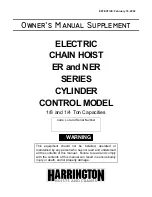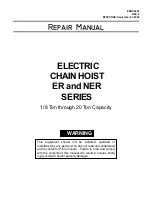
13
ENGLISH
EN
Safety instructions for electrical
chain hoists
The chain hoist may only be use to lift loads that do
not exceed the maximum load capacity set out in the
technical data and on the nameplate provided by the
manufacturer.
Do not overload the chain hoist!
The permanent suspension of objects is not permit-
ted.
Before using the chain hoist, check that the chain and
the fastening hooks are in good condition and only
use lifting aids that are permitted for and suitable for
the load in question for securing the load.
Before carrying out the intended work with the chain
hoist, you must check the load-carrying capacity of
the weight-bearing structures.
Loads that are not secured in accordance with the re-
gulations and could fall to the floor may not be lifted.
Check the cable and/or socket for damages before
the appliance putting into operation. To avoid danger,
a damaged mains supply pipe must be replaced by
the manufacturer.
Do not move loads that could roll or fall over by them-
selves. If necessary, take action to avoid this.
Stay alert, watch what you are doing and use com-
mon sense when operating a power tool. Do not use a
power tool while you are tired or under the influence
of drugs, alcohol or medication.
Keep children and other persons including animals in
a safe distance when using the appliance. Minimum
safe distance is 5 m.
It is prohibited to stand or work under suspended
loads.
Switch off the apparatus, disconnect it from mains by
unplugging and allow it to cool down before setting
up, retrofitting, cleaning, performing maintenance,
storing or transporting the apparatus.
Do not abuse the cord. Never use the cord for carry-
ing, pulling or unplugging the power tool. Keep cord
away from heat, oil, sharp edges or moving parts.
Pulling the cable could damage both the cable and
plug. As a result, electric safety would no longer be
guaranteed.
Only use splash proof extension cables approved for
outdoor purposes.
Wear suitable protective clothing such as sturdy
shoes with non-slip sole, robust long trousers, gloves,
safety glasses and hearing protection!
Do not wear loose clothing or jewels. Hear, clothing
and gloves must be out of reach of moving parts
as they could get caught by the rotating parts. Do
not use the appliance when barefooted or in open
sandals.
Do not overreach. Keep proper footing and balance
at all times.
Do not use the appliance in bad weather, especially
when there is a risk of storm.
Provide adequate lighting or good lighting conditions
when working with the machine..
Keep work area clean and well lit. Cluttered or dark
areas invite accidents.
Do not touch any dangerous moving parts
before the machine has been disconnected from the
power supply and the moving parts have come to a
complete standstill.
Check all screw and plug-in
connections and protective equipment if firm and
tightened properly and whether all moving parts
are running smooth whenever the appliance is to
be put into operation.
The protective equipment on the appliance is
strictly prohibited to be disassembled, changed,
used in conflict with the designation and it is
prohibited to attach any protective equipment of
other manufacturers.
The machine must not be used under any
circumstances if the machine or the safety devices
are damaged.
The chain hoist has a limit stop that stops the
motor in the event the chain is retracted entirely.
Do not expose tools to rain. Do not use tools in damp
or wet locations.
If operating a power tool in a damp location is
unavoidable, use a residual current device (RCD)
protected supply. Use of an RCD reduces the risk of
electric shock.
Do not use the device near flammable liquids or ga-
ses. Risk of fire and explosion in case of short circuit.
Store the device and its accessories in a dark, dry
and frost free place, which cannot be accessed by
children.
The packaging protects the machine against damage
during transport. Packaging materials are usually
chosen based on environment aspects and waste
treatment principles and are therefore recyclable. Re-
turning the packaging into material circulation saves
raw materials and reduces waste production. Parts of
packagings (e.g. foils, styropor®) can be dangerous
for children.
Residual Risk
Even when the device is used properly and all safety
regulations are complied with, there still may be
some residual risks.
Limbs may be crushed when lowering the
load.
When lowering the chain hoist, do not reach
or stand under the load.







































